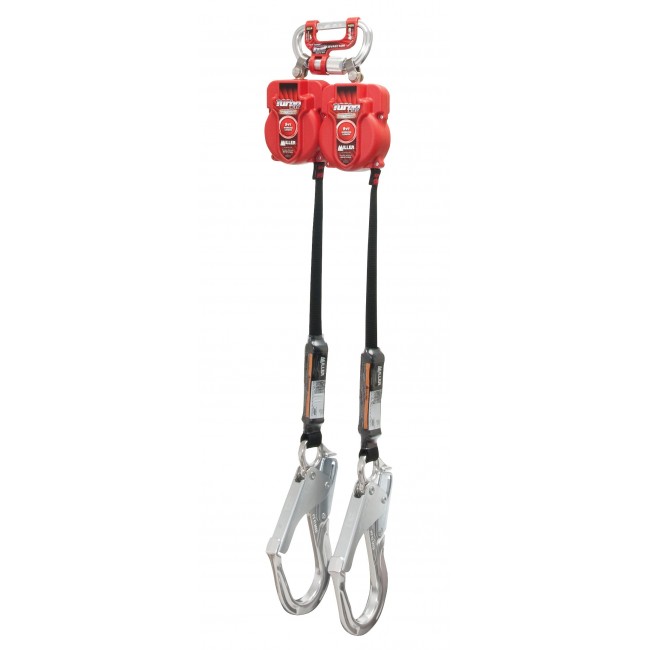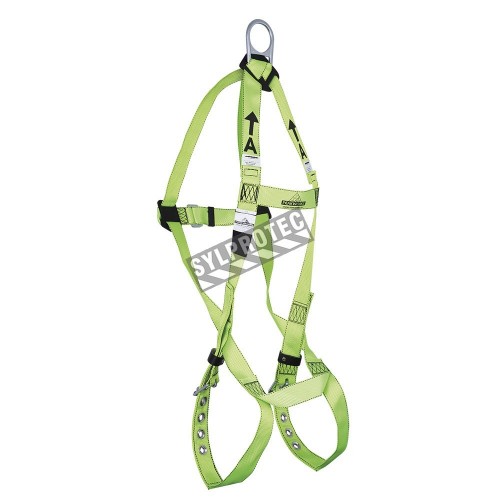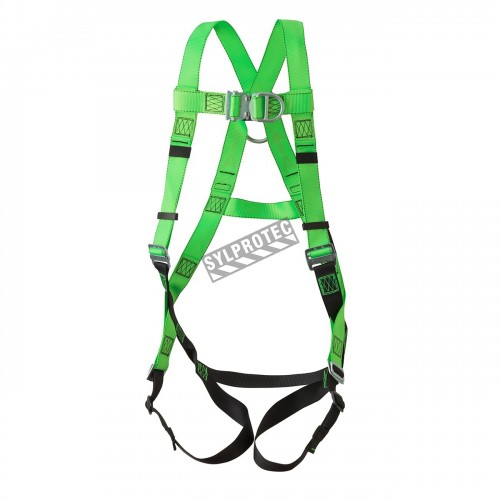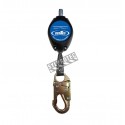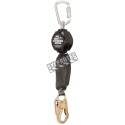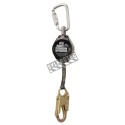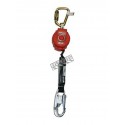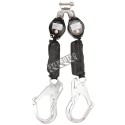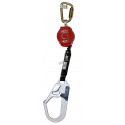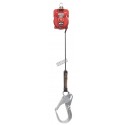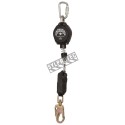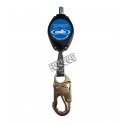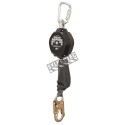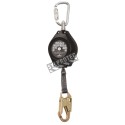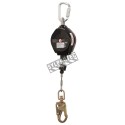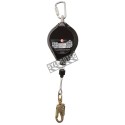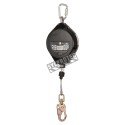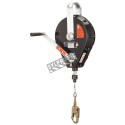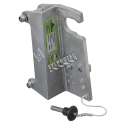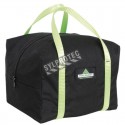FPMFLC/12/Z7/9F
Miller Twin TurboLite personal fall limiter system with 2 rebar/scaffold carabiners and 2 energy absorbers. 1 in x 9 ft.
Miller Twin TurboLite self-retracting lanyard system or personal fall limiter (PFL). This self-retracting lanyard system has 2 identical MFL/12/Z7/9FT devices also by Miller which allows one to remain connected to a safety system when passing intermediate anchor points. This safety device offers greater anchoring mobility and versatility than any other, and allows one to save time. Polyester straps with Vectran cores engineered for abrasion and hostile condition resistance.
Dimensions of each lanyard
Thickness: 1/16 in (1.5 mm)
Width: 1 in (25.4 mm)
Length: 9 ft. (2.74 m)
This two-legged self-retracting lanyard is equipped with a G2 connector, two SofStop shock absorbers and two rebar/scaffold carabiners with a 2½ in (63.5 mm) throat opening. Moreover, the straps are design to wind up automatically and stop at 24 in (0.61 m) from each carabiner which facilitates its withdrawal and avoids a significant tightening on the housing.
This self-retracting lanyard system deploys over a distance of 2 ft. (0.61 m) and has the clear advantage of a reduced free fall distance compared to regular lanyards. This self-retracting lanyard is equipped with a G2 Connector that easily connects 2 Miller TurboLite (FPMFL/12/Z7/9FT). Each of the housing swivels in multiple directions which gives a greater mobility to the worker and prevents the twisting of the webbing. This PFL is easy to use and assemble, see the manufacturer’s manual for more information. The carabiners are design to withstand a force of 3600 lbs (16 kN) and require a double-locking action for a throat opening of 2 ½ in (63.5 mm).
Miller Twin TurboLite personal fall limiter mounted to an overhead anchorage connector can support a weight of 310 lbs to 400 lbs (140 kg to 181 kg), including clothing, tools and equipment. If an overhead anchoring isn’t possible, a horizontal use may be necessary but the capacity of the self-retracting lanyard will depend on the weight of the worker. Thus a worker weighing 310 lbs can be anchored as low as 3 ft. below the harness back D-ring, but a worker weighing 400 lbs can only be anchored as low as 2 ft. below his D-ring.
During a fall, the energy absorber deploys over a distance of 2 ft. (0.61 m) to reduce the fall arrest force upon the worker. The housing’s brake system combine with the SofStop shock absorbers will limit the forces exerted on the worker. A worker weighing 310 lbs or less will be subjected to a peak fall arrest force of 4 kN (900 lbs) and a worker weighing up to 400 lbs may be subjected to a force of 8 kN (1800 lbs). Once the equipment has withstood a fall, a load impact indicator will appear on the strap which shows sign of activation. The manufacturer may repair it after a positive inspection.
This product meets the standard OSHA 1926.5-02, 1910.66, ANSI A10.32, ANSI Z359.1-2007 and CSA Z259.12-01 Class 1, Z259.2.2-98 Type 1.
Miller product code: MFLC/12/Z7/9FT
The steel carabiners meet the standard ANSI Z359.1-2007 and have a 3600 lbs (16 kN) gate strength without any distortion. The G2 Connector is made of aluminum and can withstand a force of 3600 lbs (16 kN) without any distortions.
The high impact nylon housings resist shocks and corrosion, and are equipped with a built-in swivel that prevents the lifeline from twisting. Total weight: 6.6 lbs (3.0 kg).
Certification labels provided on the housing.
The anchor point should be located vertically above the dorsal anchorage ring with respect to the worker. For a safer environment, one should remain below the anchor point, so that the lanyard does not exceed a 45 degrees angle with respect to the anchor point. One may also hook the housing to the harness back D-ring, see the manufacturer’s manual for more information.
This personal fall limiter may also be installed for horizontal use which consists in having an anchor point below the harness back D-ring. In that case, the Miller Fusion™ RoofAnchorPost is the perfect tool for anchoring your Miller TurboLite on a platform where no anchor point exists. One must respect the weight limits prescribed in the manufacturer’s technical letter (see below Technical letter 009) and avoid contact with all stripped or sharp edges.
One should also be aware of the potential risk of falling. Is there a sufficient and obstacle free distance below the worker? Are there emergency measures to get him down on the ground quickly? Can the anchor point withstand a force of 5000 lbs? For more information, consult the manufacturer's manual.
The worker is responsible for visually inspecting the lanyard before each use. During this routine inspection, the worker must note any signs of degradation, malfunction, or breakage. The lanyard will have to be replaced if any such signs are detected.
On top of this routine inspection, the lanyard must be inspected by a qualified person different than the worker. The frequency of these inspections varies according to the manufacturer. Some manufacturers require an inspection every 90 days, others every 180 days, or even yearly. These inspections should be performed more often if the lanyard is worn in extreme environmental working conditions.
The recommended lifetime of a lanyard is 5 years. While some manufacturers keep silent on this topic, in practice, if the lanyard is used regularly and stored and maintained in standard conditions, its lifetime will not exceed 5 years in most cases.
Sylprotec offers a lanyard inspection service. As regards the self-retracting lanyards, the service is available from the manufacturer. Type 1 self-retracting lanyards require no annual factory recertification. This is a type 1 self-retracting lanyards peculiarity motivated by the fact that they measure less than 10 ft (3 m) so they’re not worth the effort of repair whenever they have withstood a fall. However, if a self-retracting lanyard has been subjected to a fall, it will be removed from service because of their low cost. Find out more by clicking on the Services tab, under the Sylprotec logo at the top of the page.
Any equipment that has withstood a fall or an impact must be scrapped.
For cleaning, use a gentle soap or detergent and lukewarm water (37°C). Do not use bleach, chlorine, or other abrasive or chemical products. If your lanyard is too dirty or contaminated, it is time to replace it.
Air dry in a clean environment without using heat. You can accelerate the drying process by wiping the wet lanyard with a clean absorbent wipe, or by using a fan. Avoid exposure to sunlight and to any sources of contamination.
